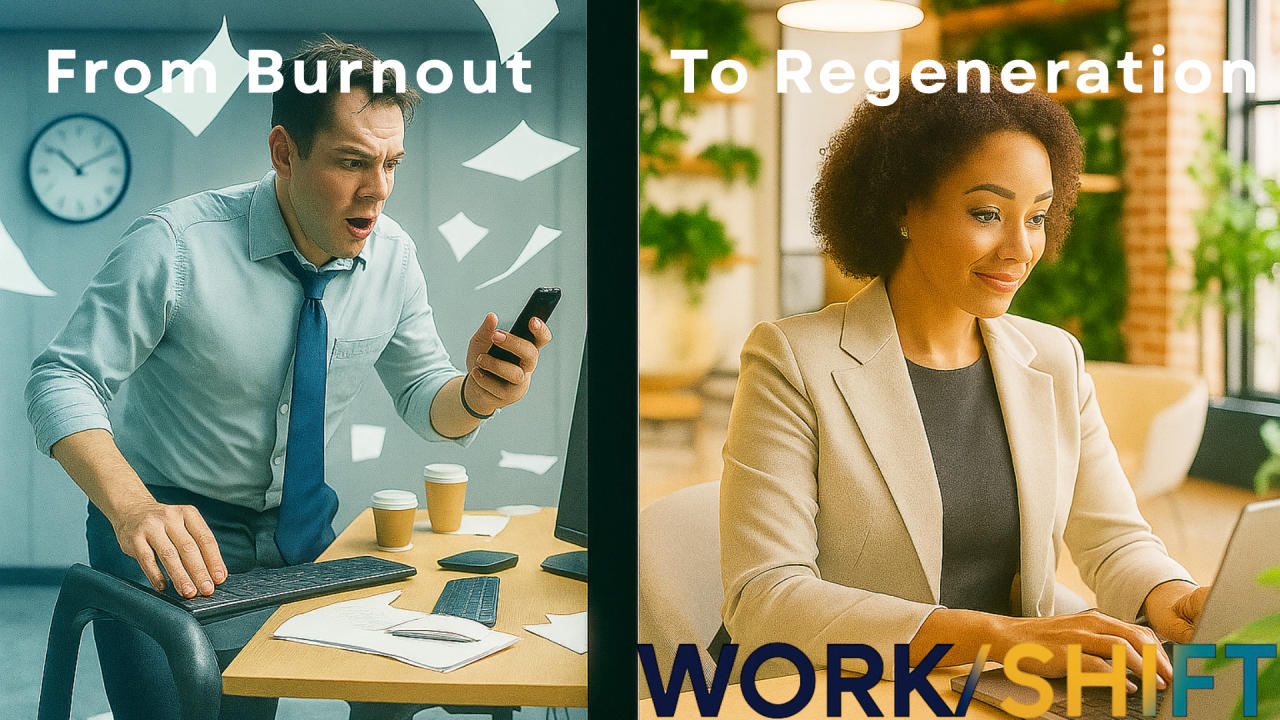Bold, human-first insights that decode work and help you design workplaces that thrive today and into what’s next.
Stop Chasing Productivity. Start Designing Regenerative Work.
We’ve been sold a simple promise for decades: design your workplace to drive productivity, and everything else will fall into place.

But here’s the reality: chasing productivity is a treadmill. It never stops. It demands more energy, more hours, more "outputs," while slowly draining the very people you rely on to perform.
Employees burn out, engagement drops, and innovation stalls. The harder you push, the more fragile your teams become.
The shift we need: from squeezing to replenishing
Instead of asking, "How do I get more out of my people?" leaders should be asking, "How do I design work so my people come back stronger tomorrow?"
“The harder you push, the more fragile your teams become.”
Regenerative work is an approach to work design that actively restores people’s energy, builds connection, and strengthens their capacity to thrive. It’s not about extracting maximum output at any cost. It’s about creating systems that replenish energy, strengthen relationships, and reinforce a shared sense of purpose.
When work is regenerative, people don’t just survive the week. They leave more capable, more creative, and more connected to each other and to your mission.
What regenerative work actually looks like
Regenerative work means designing workplaces that leave people better than they found them:
- Spaces that recharge, not just accommodate.
- Leadership rhythms that balance drive with care, not just more meetings.
- Team rituals that create genuine belonging, not performative check-ins.
- Processes that energise, not drain.
For example, a client I am currently working with replaced performative daily check-ins with meaningful weekly "reset" sessions focused on shared priorities and personal connection. They also introduced small recharge rituals into their team rhythms, like short focus breaks after intense collaboration sprints. The result was a noticeable lift in energy and a stronger sense of cohesion within weeks.
“I actually look forward to Mondays now.”
The key insight from this transformation is that these changes don’t need to be radical, but they do need to be intentional.
The cost of business-as-usual
The data is stark. In reviewing recent Gallup research, I saw that 76 percent of employees experience burnout at least sometimes, which contributes to the billions lost globally each year through disengagement, absenteeism, and turnover. Anxiety and chronic stress are now among the most cited reasons for disengagement and attrition.
I know this personally. I’ve experienced periods of intense anxiety and burnout myself. This realisation led me to question the default playbook and explore more human, regenerative ways of working.
The new question for leaders
“When your workplace gives back more than it takes, you don’t just get higher productivity — you unlock loyalty, fresh thinking, and a healthier, more committed team.”
In an era defined by complexity and constant change, squeezing more productivity out of people isn’t a winning strategy. It is a short-term fix that erodes long-term value.
The real advantage lies in designing work that replenishes energy, supports creativity, and builds trust.
This is the competitive edge that tomorrow’s most successful organisations will share.
Where to start
The first step is seeing your workplace not just as a space or a schedule, but as an ecosystem designed to give back as much as it asks.
The missing piece I discovered was a way to precisely uncover where workplaces are draining energy and where they can better support people. This led to the development of CultureFit360™, a workplace diagnostic tool designed to meet today’s complex challenges. It helps leaders, designers, and workplace teams uncover hidden friction points, understand energy patterns, and build workplaces that truly support people.
But insight alone isn’t enough. We also help translate these insights into concrete actions, from new leadership habits to clear design guidelines, so regenerative work becomes part of daily life rather than another initiative on a slide deck.
Ready to shift?
If this resonates, I’d love to hear your thoughts below. How would your work, and your people, transform if you designed for regeneration, not just productivity?
A note on Work/Shift Insights
You might notice the look and feel evolving here. As my practice grows, this newsletter becomes even more deeply tied to Work/Shift, my strategy consultancy focused on decoding work and creating people-first, future-ready workplaces.
Nothing changes for you. You’ll keep getting bold, practical insights straight from me. But you’ll also see more behind-the-scenes tools, client stories, and frameworks from Work/Shift.
Thanks for being part of this evolution. Let’s keep upshifting work, together.
Get Work/Shift Insights direct to your inbox
Subscribe to fresh ideas on workplace design, behaviour, and the future of work.
Use or reproduction without written permission is not permitted.
© 2025 WORKSHIFT COLLECTIVE - All rights reserved - ABN 64 285 893 344

